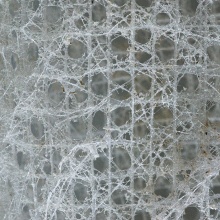Euplectella aspergillum, Venus´ flower basket from the group of glass sponges found only in seas. The name goes back to the siliceous skeleton. Only this is preserved in the preparation. The sponge is about 30 cm high and lives anchored in the mud bottom. A large central chamber is closed by a lattice-like lid. The skeletal elements (spicules) are predominantly six-rayed and bear fine branchlets at the tip. The skeleton built up from this is a model for lightweight construction and was already used in CRC 270 (Frei Otto), but was not studied in more detail at that time.
In the geological past the very old group of glass sponges (Hexactinellida) was of greater importance than it is in the seas of today.



![Silicate skeleton of the glass sponge Euplectella aspergillum (Venus' flower basket) from about 200 meters sea depth (Philippines) [F. Brümmer]; ca. 30 x 4 x 6 cm.](https://www.ub.uni-stuttgart.de/sammlungen/img-Sammlungen/Img_20210930-142952_V1920.jpg?__scale=w:720,h:1078,cx:0,cy:0,cw:1282,ch:1919)
